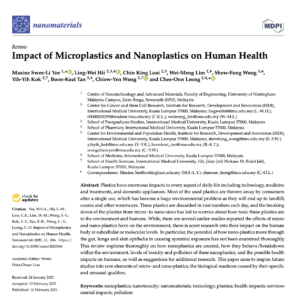This is a summary and explanation of the following research paper:
Impact of Microplastics and Nanoplastics on Human Health
Published In: Nanomaterials
On: Feb 11, 2021

This paper is a review and explanation of available research studies and literature.
Key Takeaways:
- Sources and Fate of Microplastics and Nanoplastics: The majority of plastics we are exposed to are land-derived and break down into micro- and nanoplastics, which are difficult to filter out from water systems.
- Occurrence in Food Chain: Micro- and nanoplastics are prevalent in various food products and water sources, posing a risk of human consumption.
- Uptake and Bioaccumulation in Human Body: The human body can intake these plastics through ingestion, inhalation, and dermal exposure, leading to potential bioaccumulation.
- Cellular Uptake and Intracellular Fate: Once inside the body, these plastics interact with cells through various mechanisms, affecting cellular functions.
- Potential Toxic Effects on Human Health: Studies suggest possible health risks, including inflammation, oxidative stress, and disruption of metabolic homeostasis.
Summary of Review
This study references 160 papers and also includes some diagrams that help explain how plastics can enter the bloodstream, enter cells, and disrupt processes. It’s worthwhile to look at the original study which is available online here.
Here is a little more detail on the key takeaways:
- Sources and Fate of Microplastics and Nanoplastics: These plastics primarily originate from land-based activities and degrade into smaller forms. They persist in the environment due to their resistance to natural degradation processes.
- Occurrence in Food Chain: They are found in a range of food products and water sources. Due to their small size, they can evade filtration systems and enter the human food chain.
- Uptake and Bioaccumulation in Human Body: Humans can absorb these particles through eating, breathing, and skin contact. They may accumulate in the body over time, potentially causing health issues.
- Cellular Uptake and Intracellular Fate: Once inside the body, they interact with cells in various ways. This interaction can affect cell functions and potentially lead to cellular damage or dysfunction.
- Potential Toxic Effects on Human Health: The study indicates potential health risks such as inflammation, oxidative stress, and metabolic disturbances, though more research is needed to fully understand these effects.
